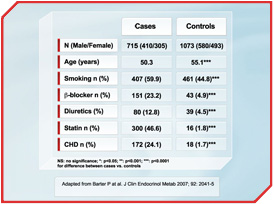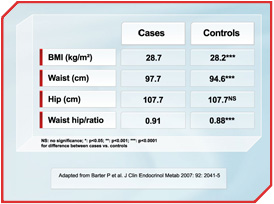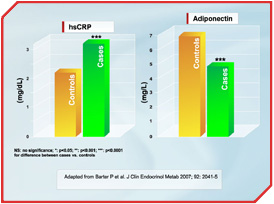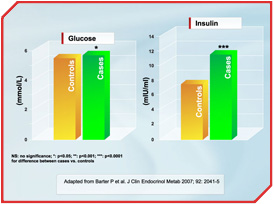Professor and Director, the Heart Research Institute, Sydney, Australia
p.barter@hri.org.au

Insulin resistance is defined as reduced insulin action leading to metabolic and vascular effects in target tissues. Whereas it is widely recognized that insulin resistance is a key pathogenic factor in the development of diabetes and cardiovascular disease (CVD), its etiology remains elusive. In this short report, we will summarize our research efforts toward establishing the potential mechanisms responsible for promoting insulin resistance in key metabolic tissues.
 [Click to enlarge]
[Click to enlarge]
The question arises: do overweight people whose plasma lipids are normal differ from their dyslipidemic counterparts in terms of the presence of the other components of the metabolic syndrome?
This question has been addressed by comparing two distinct groups of overweight people: one of people with low HDL-C cholesterol and high triglyceride (dyslipidemic group) and the other of people with a higher than average HDL-C cholesterol and a lower than average plasma triglyceride (normolipidemic group). These subjects were a subset of the GEMS Study.
Subjects were recruited from two centres in Europe (Oulu, Finland and Lausanne, Switzerland), one centre in the USA (Dallas, Texas), one centre in Canada (Ottawa), and one in Australia (Adelaide) [1].
 [Click to enlarge]
[Click to enlarge]
The study included 715 (57% male) cases and 1073 (54% male) unrelated controls (Figure 1). The mean body mass index (BMI) in the cases and controls was 28.7 and 28.2 kg/m2, respectively. The waist circumference of the cases was substantially and significantly greater than in controls. The difference in waist circumference remained statistically significant (p<0.001) when adjusted for BMI (Figure 2). Plasma hs-CRP was significantly higher in cases than controls, whereas adiponectin was significantly lower in the cases (Figure 3).
The plasma lipids in the cases and controls differed in several respects, most of which were predictable. Apart from the pre-specified differences in levels of HDL cholesterol and plasma triglyceride, cases had significantly higher levels of plasma total cholesterol, apo B, and non-HDL cholesterol than controls. Cases also had smaller LDL particles than controls.
 [Click to enlarge]
[Click to enlarge]
The concentration of plasma glucose was significantly higher in cases than controls. Fasting insulin and homa-IR were also significantly higher in cases than controls (Figure 4).
The results of this study may be of major clinical importance in the face of the worldwide epidemic of overweight and obesity and the associated increased risk of type 2 diabetes and CVD. This analysis of the GEMS study clearly indicates that not all overweight people are at the same risk, with a much higher risk group being identified by the simple measurement of plasma triglyceride and HDL-C cholesterol. The finding that overweight people who are normolipidemic tend to have normal glucose and insulin metabolism, low levels of inflammatory markers, and normal blood pressure suggests that such people may be at relatively low risk of developing diabetes and CVD despite being overweight.
 [Click to enlarge]
[Click to enlarge]
Thus, identification of people solely on the basis of an elevated plasma triglyceride and a low HDL-C cholesterol uncovers an overweight group of people who have a generalized metabolic disorder.
In contrast, overweight people with normal plasma lipids have normal glucose and insulin metabolism, low levels of inflammatory markers, and normal blood pressure. Such people may thus be at relatively low risk of developing diabetes and CVD despite being overweight.
This study emphasizes the importance of simple measures such as plasma triglyceride and HDL-C cholesterol in identifying those overweight people who have the metabolic syndrome and are at high cardiovascular risk.
References
- Barter P, McPherson YR, Song K, et al. Serum insulin and inflammatory markers in overweight individuals with and without dyslipidemia. J Clin Endocrinol Metab 2007; 92: 2041-5.



